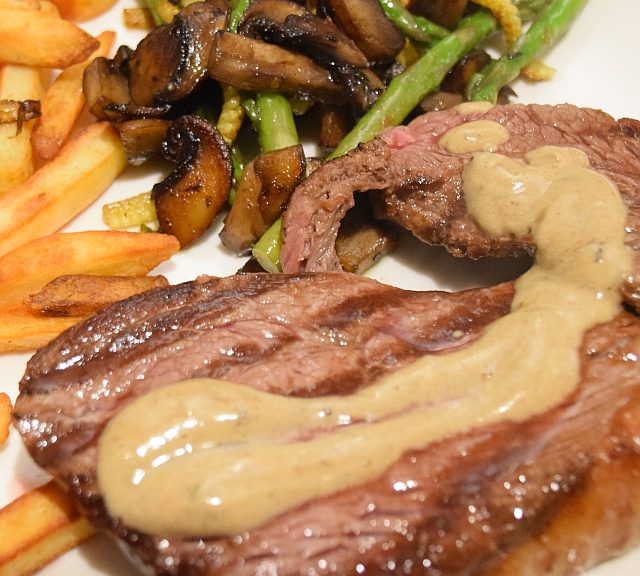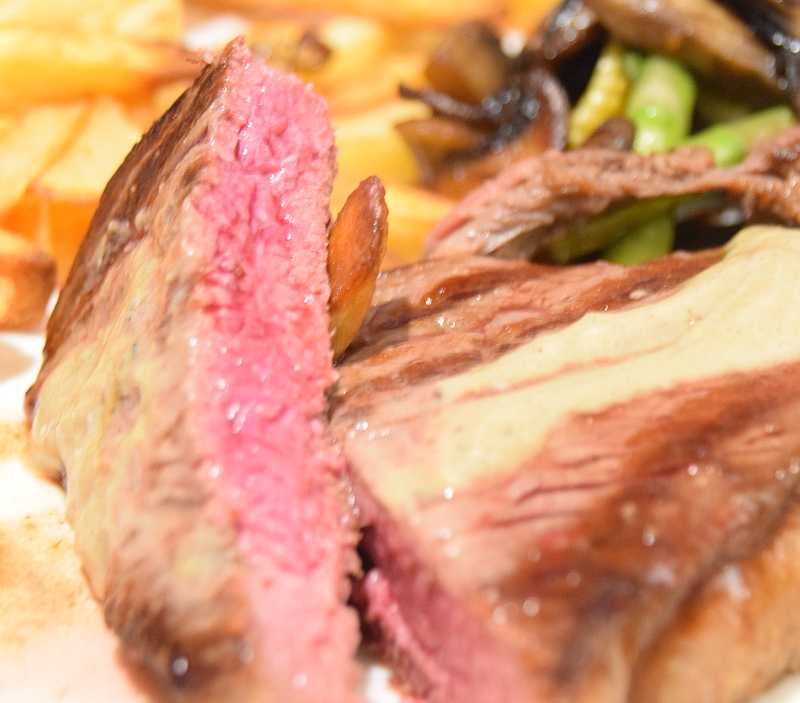
Steak – all you wanted to know but were afraid to ask
I love beef steak and so is my wife. If I would have to choose one dish that I would have to eat for the rest of your life it would be steak with a good sauce. Steak is loved by most meat eaters. Juicy, tender, full of flavour it is king of meats. But there are many cuts of steak and choosing the right might me a minefield. So I decided to compose this post to share few facts about steaks that would help you to make most out of your steak dinners.
Firstly, lets say few things about the ageing. Beef cannot be consumed straight from slaughter, it needs to hang, allowing it to mature and develop flavour and for the meat to become more tender. Beef is usually aged for 14 – 50 days, or sometimes even longer. When shopping, you can easily spot well matured beef. It will be cushion soft and will hold a thumb print when pushed in for a few seconds. It should have a beautiful dark red, almost mahogany colour. The steak should be evenly coloured. Beef that is tinged with purple shows there has been stress at slaughter. It means that adrenaline has pumped around a frightened animal at the time of death, bursting capillaries and leaving red spots in the meat. Never go for a bright red coloured cuts. One of the most vital thing to look for in beef is marbling, which runs around and through the muscle in varying amounts. You will see fine threads of creamy white fat travelling through the meat and often generous layer of fat around the muscle. This fat melts and bastes the meat during cooking, helping to make the steak juicy and pleasant to eat. If you are concerned about your fat intake, leave the fat on your steak during the cooking process, and then trim it off at the table. Never trim off the fat from the steaks before cooking as this will negatively affect the texture and flavour of your cooked meat. If you choose to eat the fat, you will be eating something that is totally natural, unlike many other unhealthy fats found in the processed foods today.
Now, when it comes to steaks remember they fall into two categories. They either have great flavour or they have tenderness. It is very rare to have both of these qualities together. Therefore it is important to select the steak cut that suit your preferences. Read on to find out what steak will best match your preferences.

Feather blade
The inquisitive foodies’ steak. This is not a very well-known cut. It comes from the shoulder blade and isn’t very big, but packs lots of flavour. It should only be cooked rare or else it will toughen. It is not at all expensive if you can find one.
Sirloin
The City boy or snob’s steak. From the middle back of cattle. It has a good size and is well marbled, but lacks true depth of flavour. It is eaten a lot more now than it used to be because modern butchers hang it to add flavour. Expensive, tender and juicy. If you are going to Sirloin steak make sure you buy well matured one for deeper flavour.
Rib-eye
The youthful trendy eaters’ steak. This comes from the fore rib. It is marbled with a central piece of fat. Because of this fat it is very tasty. This is my personal favourite!
A double rib eye on the bone is called cote de boeuf.
Fillet
The ladies’ steak. The fillet comes from inside the sirloin. This muscle does no work at all, so it is very tender and has virtually no fat. On the other side it doesn’t have a great deal of flavour. Because low fat content it cannot be hung for very long. Best cooked rare or medium rare and served with sauce to add flavour. It works really well in beef carpaccio or tartare.
Rump
The steak-eaters’ steak. This is full of flavour. It comes from the backside and must be well matured. Works really well if cooked rare or medium. My second favourite cut.
T-bone / Porterhouse
The 70’s Saturday night out steak. From the lower middle of the animal. These cuts are part sirloin and part fillet. Both cook at different rates, so it is very difficult to cook the perfect T-bone. The Americans love it, but in the UK it is in decline.
Goose skirt / Bavette
The knowledgeable cook’s steak. A flat sheet of meat, well marbled with a soft texture and delicate flavour.
Point steak
The mature and clever shopper’s steak. Older cooks tend to stick with this quirky steak. It is from the pointed, thin end of the rump where it joins the sirloin. With a funny triangular shape, it has all the flavour of rum with tenderness of sirloin.
Minute steak
The hungry and economical cook’s choice. When thinly sliced and quickly fried, this is the ideal cut for steak sandwich.
Finally, lets talk how to cook the perfect steak.
Firstly, ensure the steak is at room temperature. Immediately before cooking lightly oil your steak. Rapeseed oil will be a good choice as it can withstand high temperatures without burning. A good steak should only need a little seasoning of sea salt and pepper. Don’t season too early as salt will draw the moisture from the meat. Pre heat the frying pan until red hot and place your steaks in. Don’t overcrowd the pan as this will cause the temperature to drop and the steaks will stew in their own juices. If your steak has a fat layer on the outside, place this side on the pan first for about 1 minute. This will render the fat a bit and improve flavour of the meat. Next place your steak flat on the pan. Don’t move the steak around. After desired cooking time on one side turn the steak over and cook for the same time on the other side. Remove the steak and leave it to rest on a warm plate for at least 5 minutes before serving. This will allow the fibres of the meat to re-absorb the juices and increase tenderness. It is important to consider steak cut, size and how you want it cooked. I like my steaks medium to medium rare. I don’t mind them rare if they are of good quality but avoid well done steaks as they have less flavour and tenderness for my liking. However I understand that there are people that don’t like meat that is pink so below you can find guidance on cooking times so you can choose how to cook your steak. Times are given for each side of steak.
Fillet steak (3cm thick):
Blue: 1 minute 30 seconds
Rare: 2 minutes 15 seconds
Medium Rare: 3 minutes 15 seconds
Medium: 4 minutes
Well Done: 6 minutes
Sirloin, Rump, Rib Eye (2cm thick):
Blue: 1 minute
Rare: 1 minute 30 seconds
Medium Rare: 2 minutes
Medium: 2 minutes 15 seconds
Well Done: 5 minutes